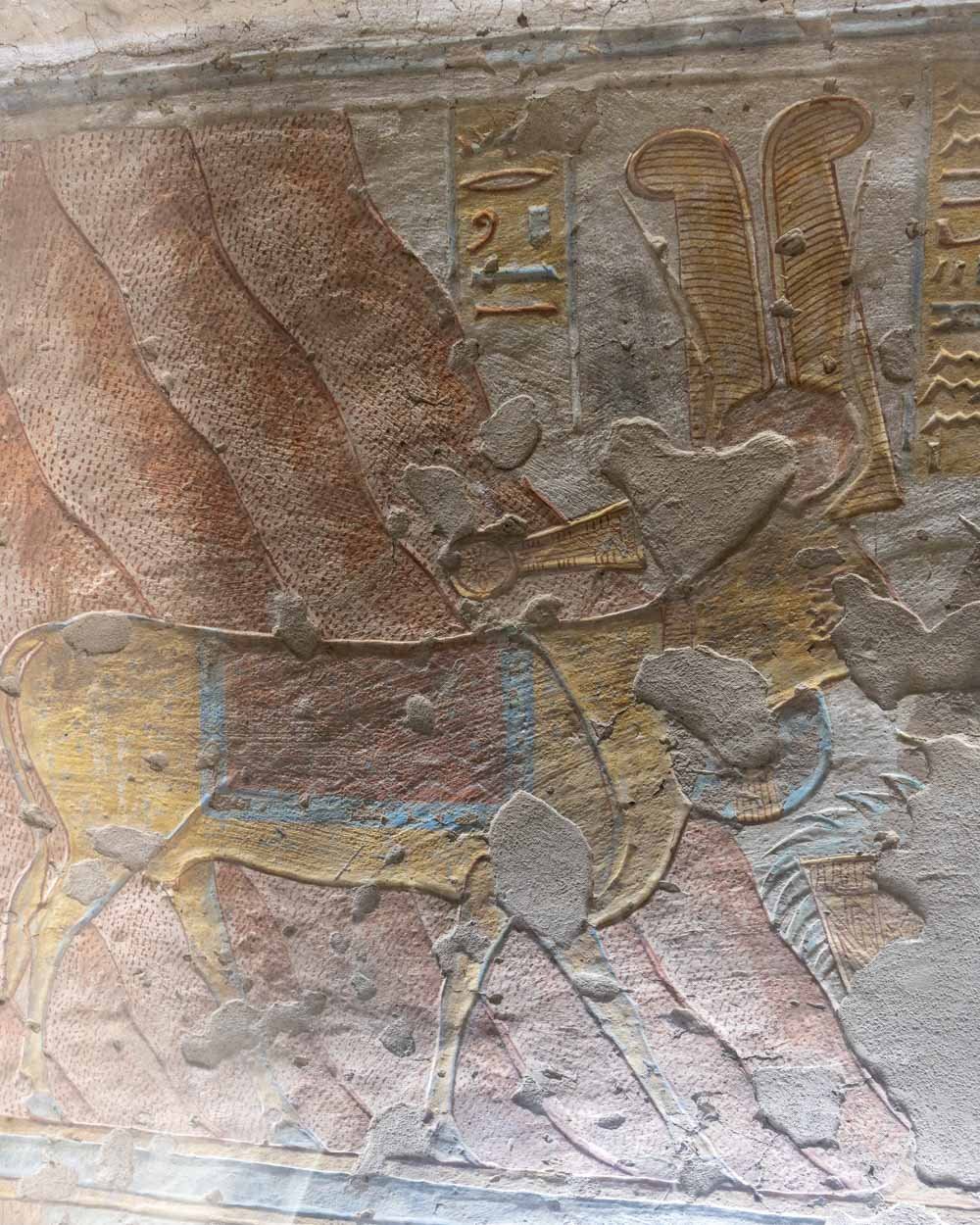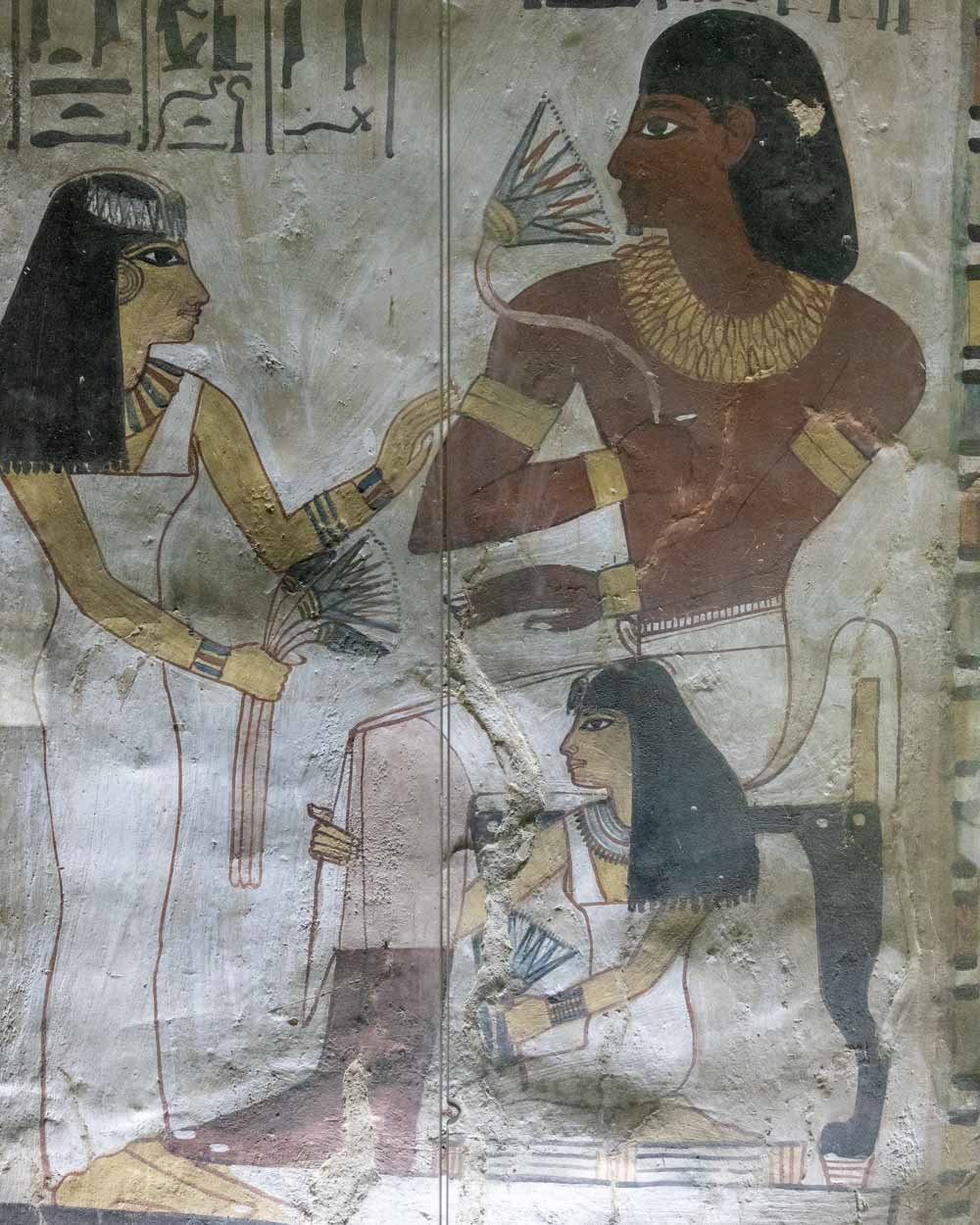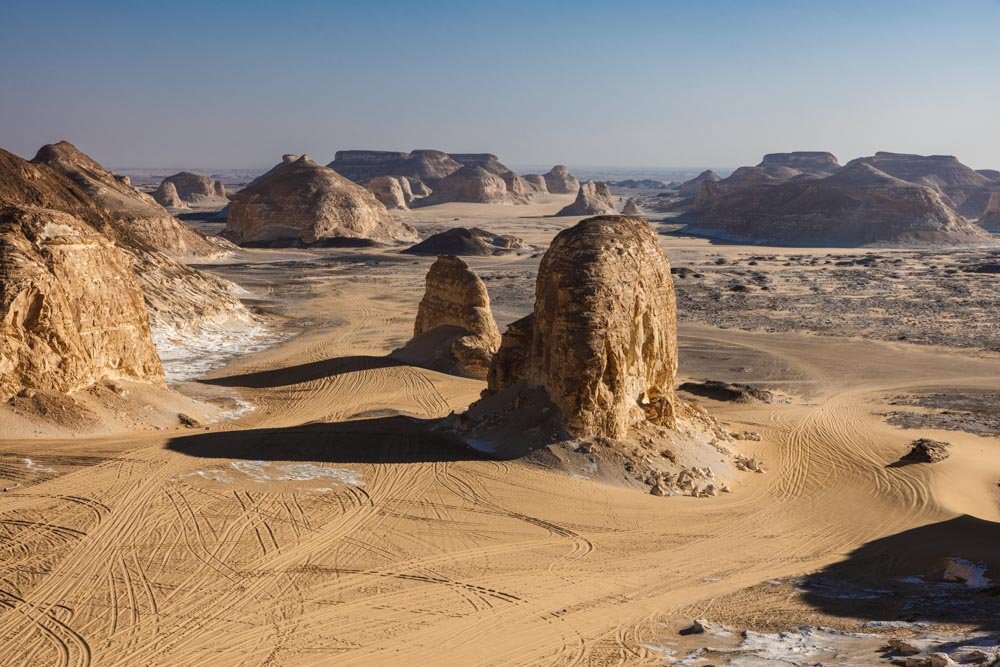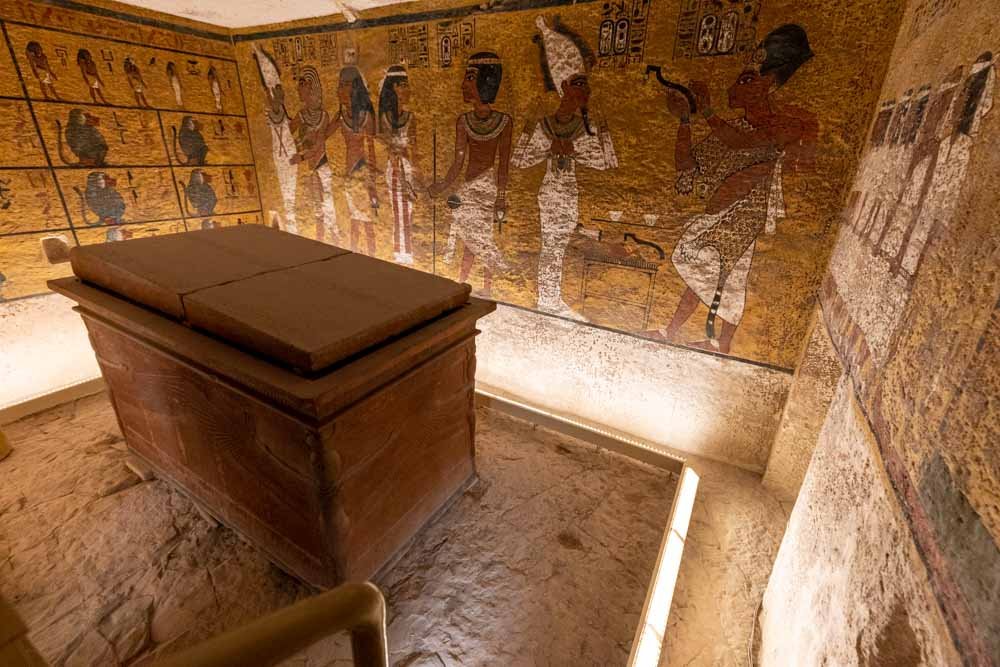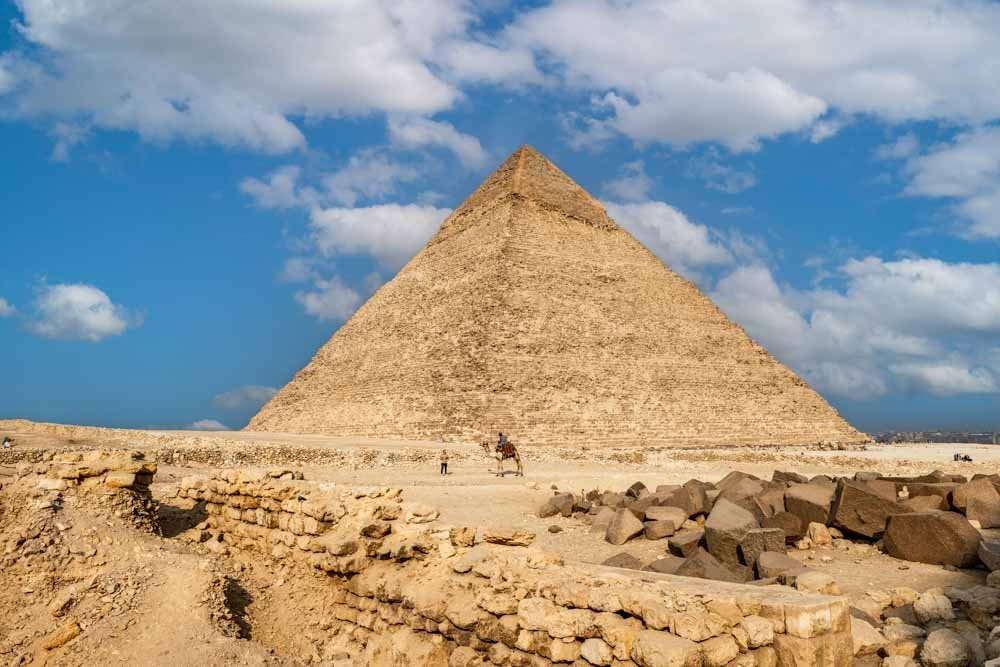Often overshadowed by the Valley of the Kings, the Valley of the Queens contains one of the greatest tombs in all of Egypt. The tomb of Queen Nefertari - Rameses II’s beloved Queen - has arguably the best preserved and most elaborate artwork of any tomb in the country.
Unfortunately the rest of the tombs are not as impressive, but they do offer the chance to immerse yourself in the paintings without the crowds you’ll find at the nearby Valley of the Kings.
Similarly, the Valley of the Nobles is overlooked by all but the most keen visitors, and is home to tombs with vivid art that showcase local life. Although less elaborate than the royal tombs, it was just as interesting to learn a little about everyday life in ancient Egypt.
In this guide we’ll take you through everything you need to know to plan your trip to the Valley of the Queens and the Valley of the Nobles, two of Luxor’s often overlooked gems.
The Valley of the Queens
Is it worth visiting?
We’ll be honest, if you don’t plan on visiting the tomb of Queen Nefertari, then visiting the Valley of the Queens is not a must do if you’re limited on time. The three tombs you can visit on the standard entry ticket: Amunherkhepshef , Titi and Prince Kha Em Wast all pale in comparison to those in the Valley of the Kings.
It’s not that they aren’t interesting sites, it’s just that they are far less grand, and all but Nefertari’s tomb are shrouded in glass, which makes them less atmospheric.
They do have one advantage though, and that’s that they’re so quiet. We barely saw another soul in the Valley of the Queens, something that can’t be said for the Valley of the Kings - and it definitely makes exploring more enjoyable.
If you are planning on visiting the tomb of Nefertari (which we’d highly recommend), then it’s worth seeing the other three tombs as they are very close by and it doesn’t take long to see them.
It’s also worth noting that only two of the four tombs that are open in the Valley of the Queens are actually queens - the other two are princes!
The tombs you can visit at the Valley of the Queens
1. The tomb of Queen Nefertari
Distance: 250m from the entrance
Accessibility: Two staircases with handrails
Additional charge: 1,400 EGP (USD $60 at time of writing but fluctuates considerably)
The tomb of Queen Nefertari is one of the best preserved historical sites in all of Egypt. Whilst it is a small tomb - there are only three chambers you’re allowed in - it has a wonderfully intimate feel, and having not long been open to the public, the majority of paintings are almost pristine.
It’s only when you see the other tombs in the Valley of the Queens (and the majority in the Valley of the Kings) that you appreciate just how much more well preserved the artwork is in Nefertari’s tomb.
The tomb has a steep set of stairs that lead to an ante-chamber and separate room on the same level, before another set of stairs leads down to a pillared burial chamber. Every inch of the walls are covered in art, and there’s a stunning dark blue ceiling with golden stars.
There are several unique pieces of art here, including a young Nefertari with tattoos on her arms, and on the opposite wall, a picture of Nefertari at a much older age. There are multiple images of Nefertari wearing the Nekhbet - a vulture crown worn by great royal wives and female pharaohs.
The low lighting inside the tomb helps preserve the art, and makes for an atmospheric experience. It does however make all of your photos come out a very deep orange. If you have Lightroom, this can be fixed by dragging the white balance slider towards the blue, revealing the white background that was actually there in reality.
Strictly speaking, you’re only allowed 10 minutes inside the tomb. However, the tomb guardians will often allow you to linger longer for a bit of baksheesh (a tip). It’s really hot inside the tomb, which the fans do little to counter, but in a way it adds to the atmosphere!
We’ve written an in-depth guide on whether Nefertari’s tomb is worth the money and what you need to know to make the most of your visit.
2. The tomb of Prince Amenherkhepshef
Distance: 300m from the entrance
Accessibility: Some stairs down to the tomb and then flat once inside
One of the furthest tombs in the Valley of the Queens from the entrance, the tomb of Prince Amenherkhepshef is included in the standard entry ticket (as with all the rest of the tombs here).
You’ll notice that Amenherkhepshef’s tomb (and the rest of the tombs currently open to the public in the Valley of the Queens) has wall to ceiling glass in front of the art to protect it, which does detract from the experience (but we completely understand why it is a necessity).
Amenherkhepshef was the son of Rameses III and sadly died in his teens. You can see artwork inside the tomb in which Rameses is holding up Amenherkhepshef to the gods, hoping they will help him journey to the afterlife.
The art inside the tomb is in pretty good condition overall, and much still retains its original colour.
The tomb is bigger than Nefertari’s, but significantly smaller than the majority of those in the Valley of the Kings. It’s made up of three rooms, two of which contain walls of art before the chamber that contains the sarcophagus. Uniquely, this tomb also has a mummified foetus, which is pretty creepy….
The tomb is fairly hot inside, but nothing like Nefertari’s tomb.
3. The tomb of Queen Titi
Distance: 275m from the entrance
Accessibility: Flat entrance and no stairs, the easiest to access
The tomb of Queen Titi is the second closest to the main entrance, but it’s one we’d suggest giving a miss if you are tight on time.
If you’d never seen an Egyptian tomb before, you’d think it was remarkable, but compared to the condition of the art in other tombs in the Valley of the Queens, Valley of the Nobles and Valley of the Kings, Titi’s tomb is not very well preserved.
Once more, the walls in all the rooms but one are covered with floor to ceiling glass. Whilst a lot of the art has some damage, you can still make out what you are looking at for the most part.
Egyptologists don’t know too much about Titi, but she’s believed to be a wife of one of the Rameses’ (they think it is probably Rameses III as the tomb is between two of Rameses III’s sons).
This tomb is surprisingly cool, which is a refreshing break from others in the valley.
4. The tomb of Prince Kha Em Wast
Distance: 300m from the entrance
Accessibility: A steepish slope up, then stairs down to the entrance. This is the least accessible for anyone with walking difficulties of the three tombs on the standard entry ticket
The tomb of Prince Kha Em Wast has the best art and colour in the Valley of the Queens after Nefertari’s tomb - so if you only have time to do one more, make sure it’s this one.
Many of the walls are covered with floor to ceiling glass, but you can still see all the art pretty well.
Prince Kha Em Wast was a son of Rameses III and he was another that sadly died young. He is thought to have been Rameses III’s oldest son.
He was known to have been the high priest of Ptah in Memphis, but didn’t become pharaoh upon his father’s death, instead the throne was inherited by Rameses III’s brother. Egyptologists aren’t sure why he was overlooked for his uncle.
Essential info about the visiting The Valley of the Queens
Planning your visit
As there are only four tombs that are open to the public (one of which you are technically only allowed in for 10 minutes - more on that later), you don’t need too long to see everything. Just one hour will comfortably allow you to visit all the tombs.
Between the car park and the entry is a gauntlet of trinket sellers who are pretty determined to try and entice you into their shop. Keep your head down and walk a steady pace and you’ll be at the ticket office and entry gate within a couple of minutes.
From the entry gate to the furthest tomb is a 300m walk that heads gradually uphill. Make sure you bring a bottle of water and any snacks you might want as there are no cafes or food stalls in the Valley of the Queens.
Getting to the Valley of the Queens
Assuming you don’t want to visit on a tour you can easily hire a taxi in Luxor, or at the ferry terminal on the West Bank. You’ll need to haggle, and make sure you state the wait time you want included. Visits to the Valley of the Queens are usually made in conjunction with the Valley of the Kings and other sites on the West Bank.
How much you pay will depend on how much you want to haggle and how far away you can negotiate from a big hotel. If you’re hanging around places like the Hilton, it’s hard because the drivers all have the rates the hotel charges (600 EGP for 5 hours at time of writing). This is much more than you can pay by negotiating with a driver directly, and as I say preferably not near an expensive hotel! The cheapest price we were offered for a full day on the West Bank pre haggle was 400 EGP.
The journey between Luxor and the Valley of the Queens takes around 50 minutes. It’s much quicker if you take the ferry. You should technically get a cheaper taxi price from the West Bank, but we always went from Luxor city.
Entry tickets
All visitors (except Luxor Pass holders) will have to buy a standard entry ticket for the Valley of the Queens, which is 100 EGP (USD $4 at time of writing). This will get you into the three tombs currently open to the public: Prince Kha Em Wast, Queen Titi and Prince Amenherkhepshef.
Technically there are still signs up saying you have to pay 300 EGP ($12 USD) to use a camera that isn’t a mobile phone - which is more than the standard entry ticket - but we were told it no longer applied during our visit (this was the same at every historical site in Egypt, we got very lucky!).
The big decision is whether to buy the ticket for Nefertari’s tomb, which is a whopping 1,400 EGP (USD $60) extra for just 10 minutes. Entry to this tomb is included if you buy the Premium Luxor Pass (USD $200) and allows entry to every historical site in Luxor. Otherwise you’ll have to buy the standard entry ticket to the Valley of the Queens and the additional ticket for Nefertari’s tomb.
Best time to visit the Valley of the Queens
Currently The Valley of the Queens is open 7 days a week from 6am to 5pm, but times sometimes change in Egypt, so do double check before you visit.
We visited the Valley of the Queens at 10am, just after Medinat Habu temple, and it was very quiet until a big tour group arrived an hour or so later. The majority of tour groups tend to descend on the Valley of the Queens in the afternoon, so we recommend visiting in the morning if you can. The tour group we encountered had tickets for Nefertari’s tomb, which made it pretty busy towards the end of our visit, which isn’t ideal.
Facilities at the Valley of the Queens
The Valley of the Queens doesn’t have much in terms of facilities. There are toilets by the entry gate that cost EGP 5, so make sure you have some small change. There are no shops serving food and drinks, so we recommend getting a bottle of water before you visit.
There are three shaded seating areas beside the tombs, which will give you a welcome break from the sun.
The Valley of the Nobles
The Valley of the Nobles is one of the quietest historical site in Luxor, and is overlooked by all but the most keen visitors. We saw two people in the entire time we visited! This is a shame because the two tombs we saw were amazing, and had paintings that were not only in great condition, but very different to all the other tombs in Luxor.
The artwork in the tombs of the nobles depict scenes of everyday life, including food, music and animals. At times, the art on the tombs of the nobles feels a bit like “Where’s Wally”, jam packed with little details, and the closer you look, the more you see.
The best tombs in the Valley of the Nobles
1. The tomb of Rekhmire
Distance: 300m from the entrance
Accessibility: Steep slope to the entrance and then flat, no stairs
Rekhmire was the vizier (the highest official and adviser to the pharaoh) of Tutmosis III and Amenhotep II. Whilst at first glance his tomb doesn’t have the grandeur of others, on closer inspection its beauty becomes apparent.
The tomb doesn’t have the same lighting you’ll find in the Valley of the Kings and Queens, so you might want to shine a torch on some of the pictures to help you see all the details. Personally I loved the low lighting, it felt a bit more rustic and atmospheric.
To the left of the entrance, you’ll see artwork on four levels, with each level showing a different race of people.
The top are the Nubians, the second are Africans, the third are Libyans and the bottom are Syrians. Keep a lookout along the second level where you’ll also spot giraffes, cheetahs, baboons and monkeys.
In the main chamber you’ll see a false door and on the right wall you’ll see a female harpist and various musicians.
You can also see Rekhmire inspecting the production of all kinds of different objects. There’s a lot to see and lingering a while to take it all in will greatly enhance your experience.
2. The tomb of Sennefer
Distance: 400m from the entrance
Accessibility: Not advised for those with accessibility difficulties. A steep slope to the entrance and a steep stairway down into the tomb which has a very low ceiling. The passages between the two rooms are also pretty low.
Sennefer’s tomb was one of our favourites in all of Luxor. The ceiling is adorned with grape vines and all sorts of bright colourful patterns, making it one of the most striking of any of the tombs we visited.
The art inside the tomb is incredibly vivid and is second only to Nefertari’s tomb in terms of how well it’s preserved (when compared to tombs in the Valley of the Nobles and Valley of the Queens).
It’s very unlikely you’ll see another soul here and we spent quite a while taking in all the details of this beautiful tomb.
The tomb guardian told us that Sennefer’s tomb was only found when excavating the tomb above, they quickly realised the ground below was hollow. They soon found a stairway that lead to the two rooms that make up the tomb.
As well as the vines on the ceiling, you’ll see depictions of the many women in Sennefer’s life (one of which is depicted giving him massages), feasts, ships and even a pair of sandals!
It isn’t easy to get to compared to most, but the tomb is well worth making the effort to visit.
Essential info about visiting the Valley of the Nobles
Planning your visit
You don’t have to worry about crowds when visiting the Valley of the Nobles, but this is not the best place to be during the midday sun. The site is very exposed, and the two tombs we talk about require a short walk uphill. It’s only 400m each way to the furthest tomb we visited though, and it’s very much worth the effort.
If you’re not comfortable walking up a steep dusty slope then it might not be for you - although we did encounter an entrepreneurial man offering motorcycle rides up to the tomb of Sennefer!
Getting to the Valley of the Nobles
The Valley of the Nobles is almost directly opposite the Ramesseum (another site that’s generally pretty quiet and well worth a look). This is a 50 minute drive from the city of Luxor and fits nicely between the Valley of the Queens (five minutes away) and Valley of the Kings (ten minutes away).
Tickets for the Valley of the Nobles
There is no ticket office for the Valley of the Nobles, so make sure you have bought your ticket before you get there. You’ll need to go to the “Antiquities Inspectorate Ticket Office” that is near the Valley of the Queens (you can find it on Google Maps by clicking here).
Facilities at the Valley of the Nobles
The Valley of the Nobles is one of the most rustic sites in Luxor, with no facilities of any kind. However, it is opposite the Ramesseum, which has a toilet and also a cafe.
The meaning behind paintings in the Valley of the Queens and Nobles
Preparation for the afterlife was very important to the ancient Egyptians. It was so important, that most pharaohs start building their tombs at the very beginning of their reign. The ancient Egyptians believed that their tombs guided their passage to the afterlife and the art inside the tombs served multiple purposes.
Firstly, the art showed the good deeds of their life, which was designed to improve their chances of passing to the afterlife. You’ll often see walls of hieroglyphs and images of the deceased surrounded by gods, showing their desired route into the afterlife. It also helped to guide the soul of the tomb owner to the afterlife, with all the information it needed to make the perilous journey.
The ancient Egyptians believed that upon your death your soul would go before Osiris, the god of the underworld. He, alongside 42 judges, would evaluate the deeds of your life and whether you had been good enough to merit passage to the afterlife.
Osiris, God of the Underworld
The final act involved weighing the heart of the deceased on a set of scales, alongside a feather of truth. If the heart weighed more, it meant the deceased had lead a bad life and their soul was consumed by Ammit, the crocodile god. Otherwise your soul would continue onwards.
The second purpose of the paintings was to show what the tomb owner desired and needed in the afterlife. This was often belongings, feasts and the ships to transport their soul.
Food for the afterlife
Where to stay in Luxor
Hilton Luxor Resort & Spa
We stayed in the Hilton in Luxor (not sponsored) and it was one of the best hotels we stayed at in Egypt. Firstly, it is a bit of a quiet oasis, you can step into your room and escape the road noise and bustle of the streets of Luxor. The beds were incredibly comfortable, the rooms were spacious and the showers were perfect for washing off the dust from a day visiting the West Bank.
The breakfasts served here were really good and a great way to prepare for a day exploring. Set on the banks of the Nile, we loved grabbing a coffee in front of the river and viewing the mountains of the Valley of the Kings, Queens and Nobles in the distance.
They will also help you organise taxis that aren’t extortionate and are great for people who don’t want to spend all their time trying to haggle with taxi drivers. However, deal hunters will be able to get a better price in the centre of Luxor (the taxis on the street in front of the Hilton will go by the Hilton’s price list and generally won’t deviate much).
This post may contain affiliate links, meaning at no additional cost to you, that we will earn a small commission if you click through and decide to make a purchase. This helps towards the costs of running our website. Thanks for your support!













